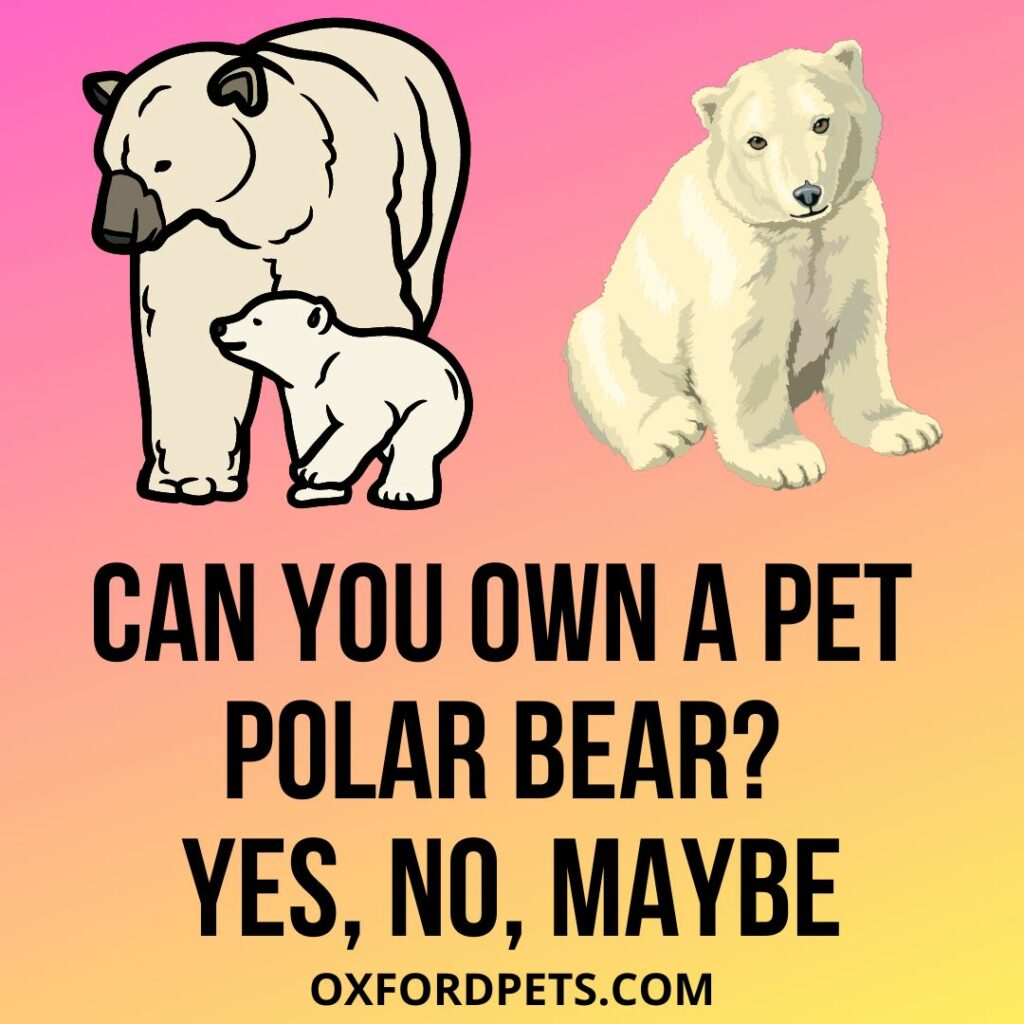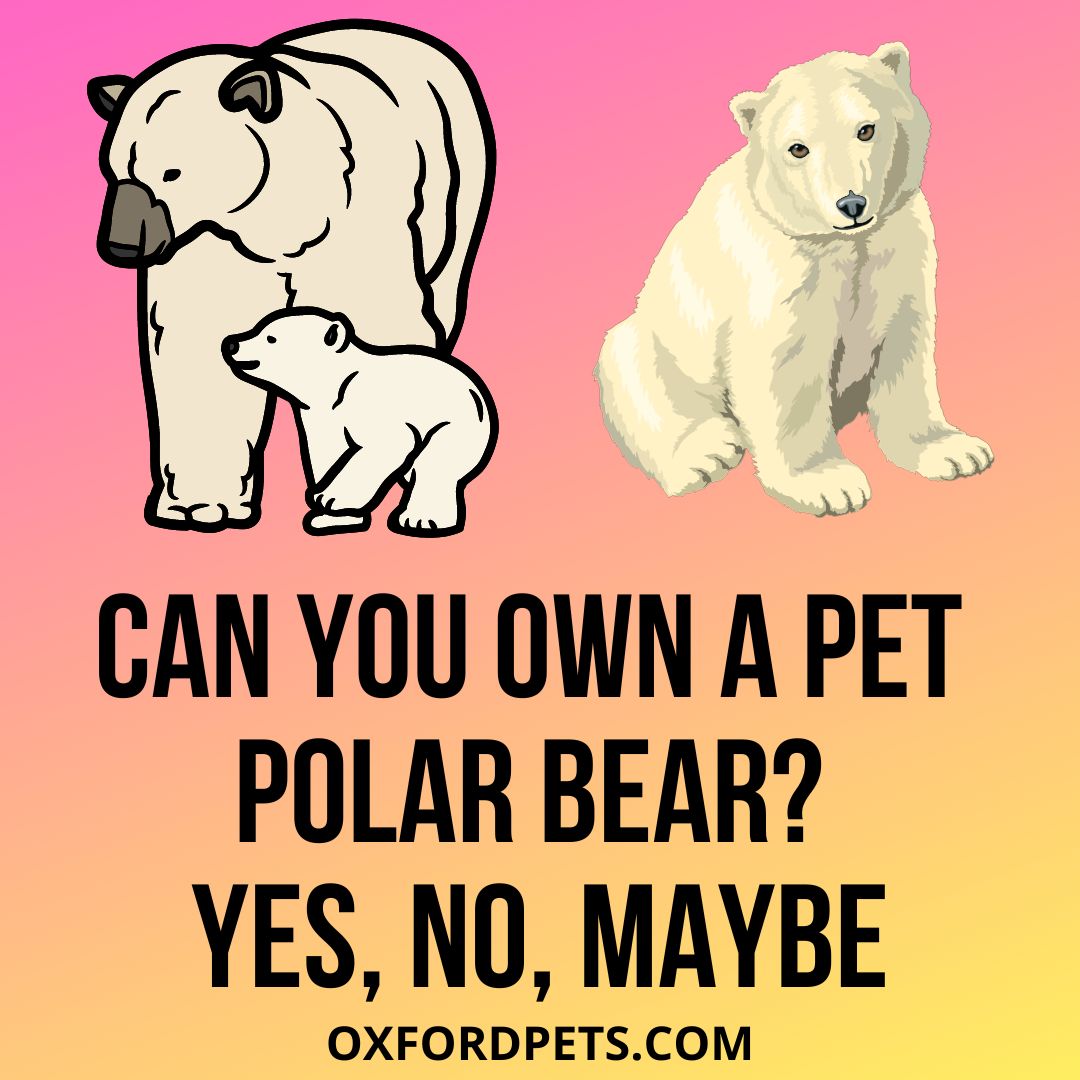Is it possible to keep a Polar Bear as a pet? Well, there is no other animal cuter than a Polar Bear. However, keeping them in captivity isn’t encouraged.
With their fluffy fur and chubby body, several individuals may bluff into believing they as great pets. But the reality and truth are far from different from such beliefs. Come, let’s learn more about it.
Contents
- Getting a Pet Polar Bear: What You Need to Know
- Where did the polar bear originate from?
- Polar Bear Species Taxonomy chart
- Do Polar Bears Make Good Pets?
- Is It Legal To Keep Polar Bear As A Pet?
- Are Polar Bears legal in the US?
- Can you have Polar Bears as Pets?
- Polar Bear Housing Needs
- Polar Bear Temperature and Humidity Needs
- Polar Bear Dietary Needs
- Polar Bear Cleaning
- Common Health Problems with Polar Bears
- How Much Does a Polar Bear Cost?
- Where To Buy a Polar Bear?
- Frequently Asked Questions
- Wrapping up…
Getting a Pet Polar Bear: What You Need to Know
What is a Polar Bear? The polar bear is a large, hypercarnivores bear native largely within the Arctic Circle. These northern white bears are chubby, have fluffy fur, and are majorly white, off-white, and cream in color.
Polar Bears are also the largest and most powerful carnivore present on the land. Along with that, they are also the largest extant bear species left on the earth.
Polar bears, though most are born on land, spend the maximum of their lifetime on the sea ice. This fact also gives them their scientific name, ‘Maritime Bear’. Polar Bears generally feed on seals; however, they don’t have any natural predators.
Besides that, they even do not have any human fear, which makes them one of the most dangerous wild animals in the world.
However, despite that, Polar bears today are categorized as vulnerable species. The major reason for the same is the rapid growth of global warming and the alarming climate change that has led to unexpected habitat loss for these poor beings.
Where did the polar bear originate from?
According to the DNA findings, Polar Bears are supposed to have evolved from brown bears (Ursus arctos) about 1 million years ago.
Their fossils, though rare, the oldest one is to be found from Svalbard (islands north of Norway) and is claimed of the last interglacial age (about 130 000 years old).
For thousands of years, these animals were also key figures in material, spiritual, and cultural life.

Polar Bear Species Taxonomy chart
| Name | Polar Bear |
| Other Name | The white bear, Sea bear, Ice bear Great white northern bear |
| Scientific Name | Ursus maritimus |
| Kingdom | Animalia |
| Phylum | Chordata |
| Class | Mammalia |
| Order | Carnivora |
| Family | Ursidae |
| Genus | Ursus |
| Species | U Maritimus |
| Conservation status | Vulnerable (Population decreasing) |
| Speed | 40 km/h (Maximum, Adult, Sprint) |
| Size | Mass: 450 kg (Male, Beaufort Sea population, Mature), 150 – 250 kg (Female, Adult)Height: 1.8 – 2.4 m (Female, Adult, On hind legs), 1.3 m (Male, Adult, At Shoulder)Length: 2.4 – 3 m (Male, Adult), 1.8 – 2.4 m (Female, Adult) |
Do Polar Bears Make Good Pets?
No, because Polar bears are wild and carry a lot of risks, they do not make good pets. Even if someone gets the license to keep them and manage their habitat, keeping them along for long is not possible. There will always be a life threat for both the animal and the keeper.
Is It Legal To Keep Polar Bear As A Pet?
Polar Bears are considered exotic pets though keeping them is not legal in most parts of the world. Instead, in Alberta and some parts of Canada, unless one possesses a specific license/ permit, they can’t keep a polar bear as a pet.
Are Polar Bears legal in the US?
States like Nevada, Oklahoma, Wisconsin, Alabama, North Carolina, and South Carolina have no restrictions on keeping bears and other big cats. However, no State, City, or County in the entire United States allows keeping Polar Bears legally.
Polar Bears are the largest carnivorous on earth, and no one should keep them around. No matter how harmless they appear in pictures, they can rip a human apart within seconds. Also, unlike many other exotic animals, Polar bears are incredibly hard to take care of.
Can you have Polar Bears as Pets?
Polar Bears are not the domestic animals you would like to see in your space. These creatures love to hunt, are dangerous, and have no fear of humans; thus, it is better to leave them alone.
And last but certainly not the least, keeping Polar Bears as pets is illegal and can land you in trouble. Considering all of these, it is better to drop the idea of having Polar Bears as pets.
Polar Bear Housing Needs
For housing a Polar Bear in captivity, at least 2 acres of space is necessary. Meeting the highest possible standards, it must have a closed climatic controlled chamber that can meet their needs like wild.
Remember, it isn’t as simple as providing some ACs since, in Artic, these animals are habitual of surviving in temperatures as low as -50 degrees Celcius. Also, Polar Bears are marine animals; thus, their habitat must consist of a large and deep swimming pool (nonchlorinated).
Besides that, like any other animals, they all require a variety of substrates in their enclosures. For instance, shaded areas for shelters, soft areas for digging, rocks for climbing, and places for hiding from the public.
Wild Polar Bears also need company, and thus it is important to socialize them with others from their tribe once in a while.
Polar Bear Temperature and Humidity Needs
Polar Bears are native to the Arctic, and thus the temperature and humidity needs accordingly are,
-69°C to -1.5°C. These animals can also manage under the sun; however, they need constant cooling around them.
Sudden rises in temperature and over-exposure to the sun can prove harmful for them.
NOTE: Polar bears who have been kept in warm and humid environments (In Japanese and Singapore Zoo) turned green in color due to algae.
Polar Bear Dietary Needs
Polar Bears are hardcore Carnivorous; thus, in the wild, their diet consists of only Meat. However, in captivities like Zoos, balancing what they eat is very crucial.
Polar bears feed on ringed and bearded seals, bowhead whales, scavenge on carcasses of beluga whales, walruses, narwhals, and more. In circumstances when none of these is available, they will eat any meat at that point.
They need 2 kgs of fat per day in order to survive; however, in captivity, it is important to focus on irregular feeding opportunities.
Polar Bears in Zoos don’t need daily feeding. It is because they aren’t involved in as intense physical activity as they would in the wild.
Also, it is important to supply the Polar Bears with some blocks of ice during the summer months. It will help them keep cool internally as well.
Polar Bear Cleaning
Polar Bears are cleaning freaks, and thus they like everything around (including self) to clean all the time.
After having their meal, they will station near a pool of water in order to clean their face and paw.
For self-cleaning, they will swim hours inside the pool. However, soon after, Polar Bears will shake them off since they can’t keep wet for long.
Cleanliness also helps in keeping the insulating properties of their fur intact.
Common Health Problems with Polar Bears
Polar Bears commonly suffer from four morbilliviruses,
canine distemper, dolphin morbillivirus, phocine distemper, and porpoise morbillivirus.
All of these are known to be present in the Arctic and have been documented in polar bears from Alaska and Russia as well.
How Much Does a Polar Bear Cost?
It is extremely hard to put a price on Polar Bear’s existence. The reason is, Polar Bears are nowhere on sale, and thus, finding their cost isn’t very possible.
Besides what there is down cost, experts suggest that keeping a Polar Bear can prove very expensive.
These animals are long-term responsibility since they live for over 30 years. During this time frame, caring for them is four times or even more than caring for a human.
Where To Buy a Polar Bear?
Where To Find a Polar Bear Breeder? While you are looking to buy a Polar bear, you will have a hard time finding them for sale. All of the specialized breeders work with Zoo and other similar organizations.
Thus, these individuals do not deal in buying and selling Polar Bears to regular individuals. They will sell baby bears only to Zoos that have valid licenses/permits.
Frequently Asked Questions
Can I adopt a baby polar bear?
It is not possible to humanely bring home a baby polar bear and nurture it for life. Instead, one can contact World Wild Fund (WWF), adopt a Polar bear, and contribute to their health and well-being. It is more like sponsorship where you can pay the organization for the betterment of Polar Bears in general.
How many polar bears are left?
According to Scientists’ estimation, there are fewer than 26,000 polar bears left in the world today. Studies predict that due to climate change, these creatures will face reproductive failure and extinction by 2100.
Are Polar Bears Friendly?
Polar bears are wild, predators, and absolutely unpredictable. They aren’t friendly with any other animal species or humans. It is possible that in any chance interactive, Polar bears will attack humans or other animals within no time.
Is Owning a Polar Bear a Good Idea?
No, the idea of owning a Polar Bear or any large Carnivorous is never a good idea. Even when hand-raised from the time they are born, Polar Bears can attack their human owner at any time of their life. Also, since they are exceptionally powerful, keeping them anywhere around is not at all safe.
Wrapping up…
Can you own a pet Polar Bear? No, it is neither possible nor a good idea to keep polar bears as pets. Even any bear species, for that matter, isn’t meant for domesticating.
To show your love for animals, it is always better to visit a zoo and observe them from afar. Or contribute to one of those many animal welfare organizations and shower your love on the animals.
